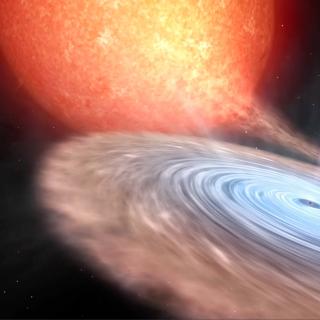Bibcode
Castro Segura, N.; Knigge, C.; Matthews, J. H.; Vincentelli, F. M.; Charles, P.; Long, K. S.; Altamirano, D.; Buckley, D. A. H.; Modiano, D.; Torres, M. A. P.; Buisson, D. J. K.; Fijma, S.; Alabarta, K.; Degenaar, N.; Georganti, M.; Baglio, M. C.
Bibliographical reference
Monthly Notices of the Royal Astronomical Society
Advertised on:
1
2024
Citations
6
Refereed citations
6
Description
The evolution of accreting X-ray binary systems is closely coupled to the properties of their donor stars. Consequently, we can constrain the evolutionary track a system is by establishing the nature of its donor. Here, we present far-ultraviolet (far-UV) spectroscopy of the transient neutron-star low-mass X-ray binary J1858 in different accretion states (low-hard, high-hard, and soft). All of these spectra exhibit anomalous N V, C IV, Si IV, and He II lines, suggesting that its donor star has undergone CNO processing. We also determine the donor's effective temperature, Td ≃ 5700 K, and radius, Rd ≃ 1.7 R⊙, based on photometric observations obtained during quiescence. Lastly, we leverage the transient nature of the system to set an upper limit of $\dot{M}_{\rm acc} \lesssim 10^{-8.5}~{\rm M}_{\odot }~\mathrm{ yr}^{-1}$ on the present-day mass-transfer rate. Combining these with the orbital period of the system, Porb = 21.3 h, we search for viable evolution paths. The initial donor masses in the allowed solutions span the range 1 M⊙ ≲ Md,i ≲ 3.5 M⊙. All but the lowest masses in this range are consistent with the strong CNO-processing signature in the UV line ratios. The present-day donor mass in the permitted tracks are 0.5 M⊙ ≲ Md,obs ≲ 1.3 M⊙, higher than suggested by eclipse modelling. Since Porb is close to the so-called bifurcation period, both converging and diverging binary tracks are permitted. If the former is confirmed, J1858 will end its life as an ultracompact system with a substellar donor.
Related projects

Black holes, neutron stars, white dwarfs and their local environment
Accreting black-holes and neutron stars in X-ray binaries provide an ideal laboratory for exploring the physics of compact objects, yielding not only confirmation of the existence of stellar mass black holes via dynamical mass measurements, but also the best opportunity for probing high-gravity environments and the physics of accretion; the most
Montserrat
Armas Padilla